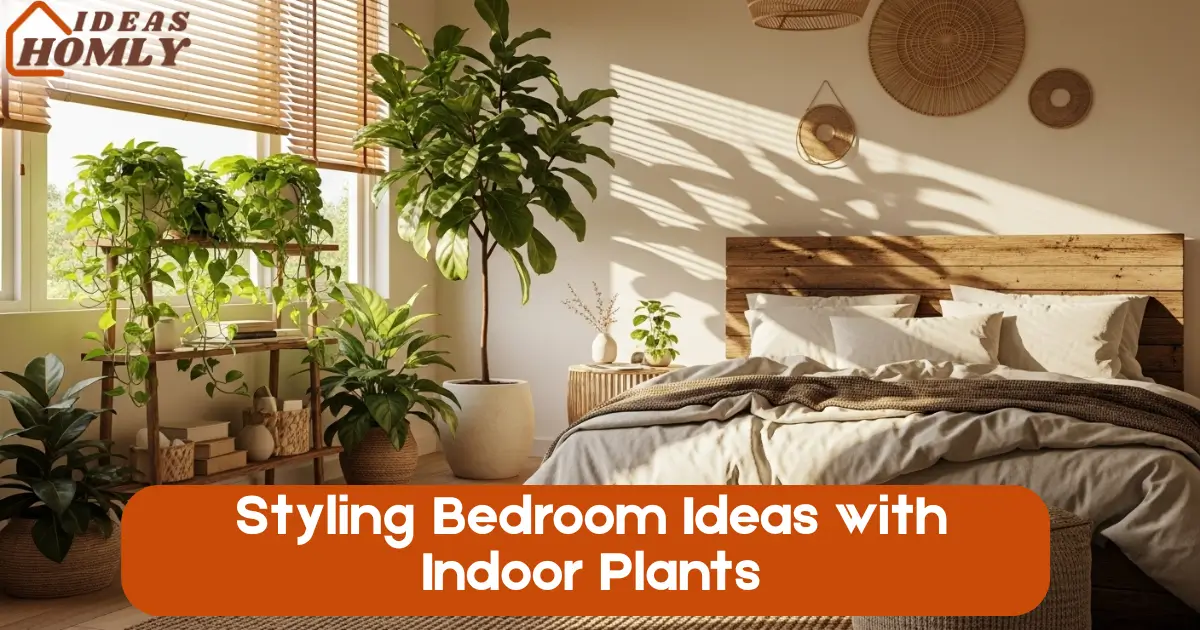I’ve always believed a bedroom should feel like a retreat, not a storage unit with a bed in it. And let’s be honest nothing turns a tired room into a calming haven faster than the right mix of indoor plants and natural textures.
Lately, we’ve all become obsessed with cozy spaces that breathe. That’s why bringing nature indoors isn’t just a trend, it’s a lifestyle upgrade. From lush greenery to raw wood accents, this earthy aesthetic is popping up in the most stylish bedrooms across Pinterest and beyond.
But it’s not just about looks. Indoor plants actually help purify the air, reduce stress, and improve sleep. Pair that with the warmth of natural elements like linen, bamboo, and stone, and you’ve got a space that’s not just pretty, but good for you too.
Now, let’s talk about five stylish ways I’ve personally experimented with in my own space and why you might want to steal these ideas for your own bedroom.
1. Floating Macrame Shelves with Cascading Ferns
If your nightstand is already full of your “bedtime essentials” (aka five half-read books and a water bottle from 2022), you need to go vertical. That’s where floating macrame shelves come in.
These charming little hangers aren’t just eye candy, they’re surprisingly practical. I love stacking them with small, trailing plants like Boston ferns, string of pearls, or pothos. They add movement, color, and that lovely waterfall effect that’s super soothing to look at when you’re lying in bed doing absolutely nothing.
Now pair those ferns with a neutral wall and some jute or raw cotton hangers, and you’ve got a dreamy combo of greenery and texture. Bonus? They don’t take up floor space, great for smaller bedrooms or renters who can’t commit to drilling in a jungle.
Stick with lightweight pots and use moisture-loving plants. The last thing you want is your shelf collapsing at 3 a.m. because your fern got too ambitious.
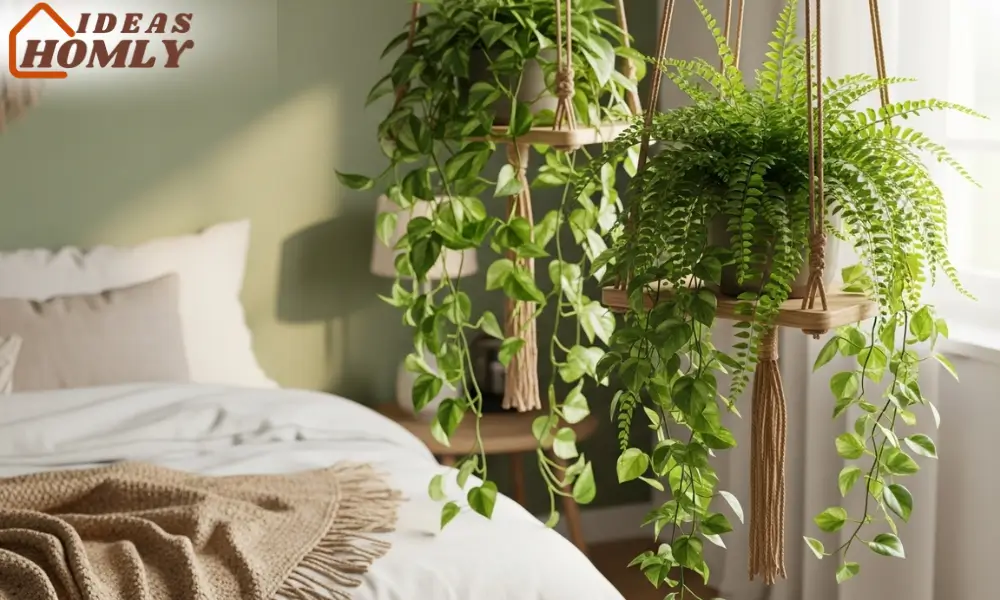
2. Large-Leaf Plants Paired with Reclaimed Wood Furniture
You know those oversized fiddle leaf figs and bird of paradise plants that scream “designer catalog”? Yeah, I’m a total sucker for them. They don’t just add drama, they own the space.
Placing one in a woven basket beside a bed made of reclaimed wood creates a visual contrast that’s rustic yet refined. The rough, imperfect texture of old wood combined with smooth, deep green leaves feels grounded and lived-in like the space has stories to tell.
I’m talking chunky wood headboards, raw-edge nightstands, maybe even a DIY bench made from old pallets (if you’re into weekend projects that involve swearing and splinters). Add a large indoor plant right next to it, and the space instantly looks intentional and well-curated.
Keep these big plants near a window and rotate them weekly unless you want your monstera to start leaning like it’s had a long night out.
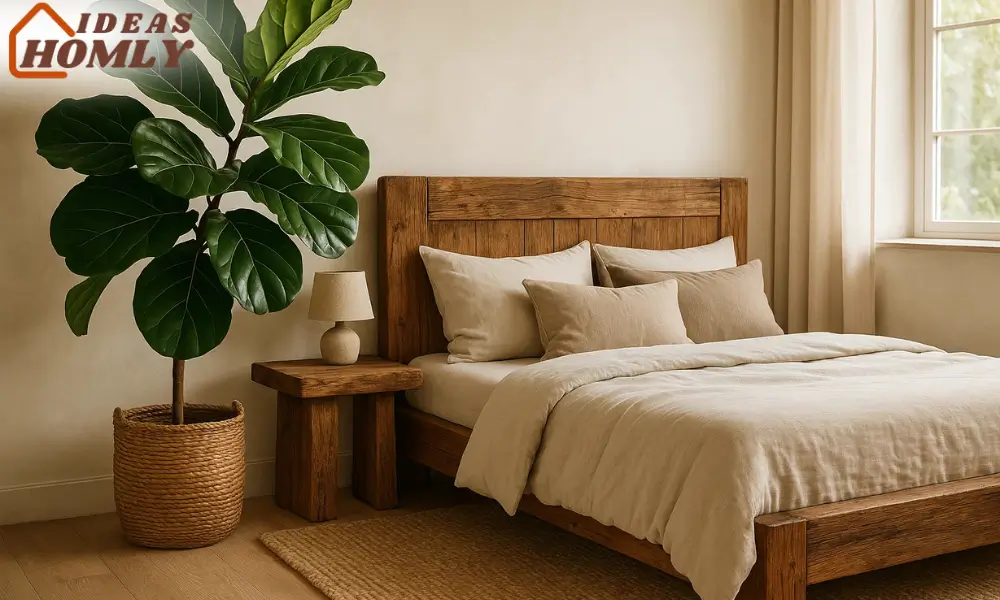
My Favorite Big Leaf Plant + Furniture Pairings
| Plant | Furniture Match | Why It Works |
|---|---|---|
| Fiddle Leaf Fig | Reclaimed Teak Bedframe | Bold leaves + warm tones = visual balance |
| Bird of Paradise | Rustic Oak Nightstand | Tall, sculptural plant pairs well with boxy textures |
| Monstera Deliciosa | Pallet Wood Bench | Adds height & movement to low furniture |
3. Hanging Air Plants with Driftwood Mobiles
I’ve got a soft spot for decor that looks like it came straight out of a coastal art studio and air plants with driftwood absolutely nail that vibe. They’re effortless, artsy, and honestly, kind of magical.
What makes air plants (a.k.a. Tillandsia) perfect for bedrooms is that they don’t need soil. Just a mist or soak now and then. So if you’re a little… forgetful, like I totally am sometimes, these guys won’t judge.
Pair them with driftwood mobiles, either store-bought or made from that beach haul you’ve been hiding in your closet. It’s a laid-back, natural look that’s all texture and movement without the clutter.
And the best part? You can hang them near windows, over dressers, or even in awkward ceiling corners where nothing else seems to work. They turn dead space into a dreamy accent wall. I once hung one right above my headboard and yep, it turned my plain bed into the “ocean zen zone.”
Add some soft fairy lights around the driftwood for a cozy nighttime glow. Just keep the bulbs away from the air plants they’re not fans of toasty vibes.
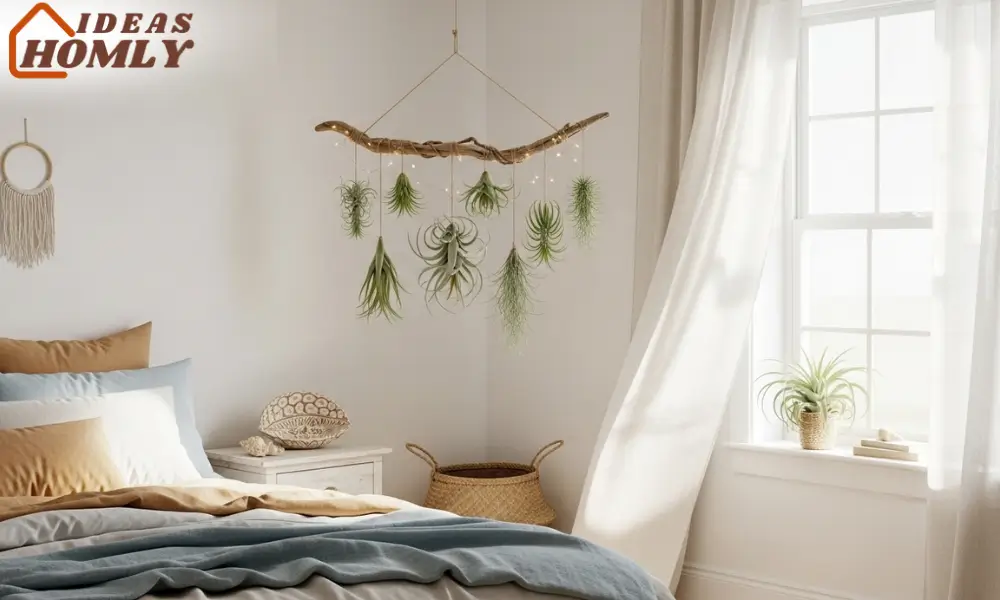
4. Vertical Moss Art Paired with Pebble Decor
If you’ve never considered moss art, let me tell you, you’re missing out on one of the coolest and most underrated plant trends out there. Think of it as a living painting (that thankfully doesn’t need sunlight or constant misting).
Moss walls or frames instantly give your room that serene, spa-like feeling. You don’t need to go full “jungle hotel” either, a simple square or circular panel can add depth and interest to a blank wall.
Now here’s where things get extra fun: pebble decor. I’m talking pebble trays under planters, pebble-filled vases, or even a DIY pebble mat for under your bedroom plant corner. The texture contrast is subtle but powerful soft moss vs. rugged stone creates a balanced, grounded aesthetic.
These earthy additions really shine when paired with neutral linen curtains or muted tones on the bed. The room feels calm, tactile, and kind of like a place you’d want to curl up with herbal tea and pretend you don’t have emails to answer.
Preserved moss is best for bedrooms, it looks fresh without needing much care. If you go for live moss, keep it out of direct sun and mist it often to stay plush.
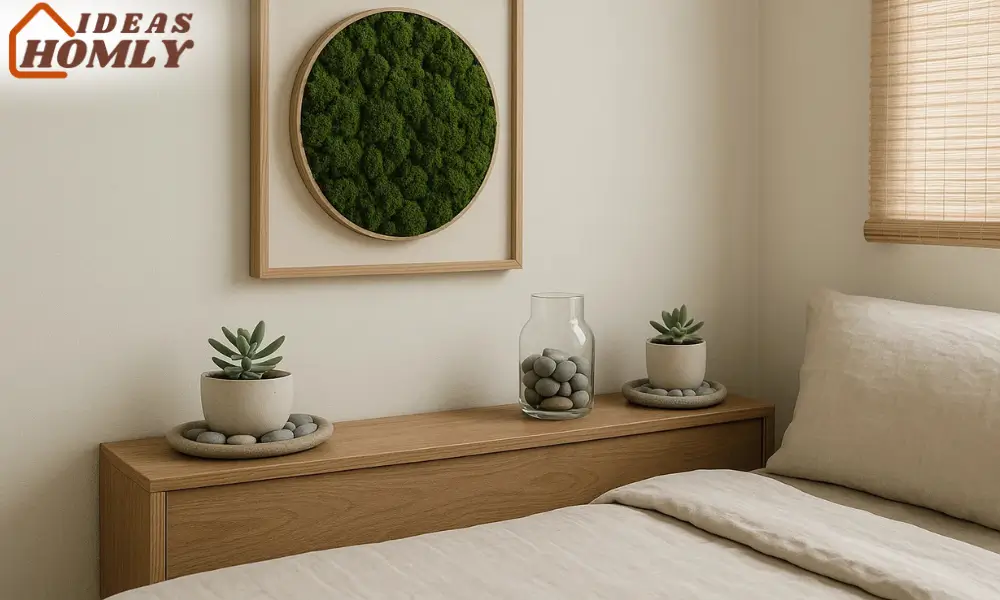
Quick Moss & Pebble Styling Tips
Best Moss Types:
- Sheet Moss (for even, clean look)
- Reindeer Moss (for a soft, bubbly texture)
Where to Use Pebbles:
- Under planters for a modern touch
- As part of a zen corner with candles and succulents
- In clear glass jars for layered texture
5. Mixing Planter Materials for Textural Contrast
Let’s be honest one terracotta pot is cute. Ten terracotta pots? Snooze-fest. If you really want your plant styling game to pop, you’ve got to mix up your planter materials.
Think ceramics next to rattan, or metal planters paired with raw concrete ones. That contrast? Chef’s kiss. It instantly makes a basic room feel like it belongs in a design magazine.
I’ve found that mixing textures lets each plant’s shape and color shine even more. A trailing ivy in a matte black pot feels bold and dramatic. But place a cactus in a woven basket, and suddenly the vibe is warm and relaxed.
You don’t even need to spend big. I’ve reused old bowls, baskets, even mugs (yes, mugs) as mini planters. The key is balance, don’t cluster all the same materials together. Spread them out to keep the eye moving across the space.
And if you’re worried about drainage (because we’ve all killed a plant or two), just add a plastic liner or saucer inside. Stylish and practical, look at us adulting like pros.
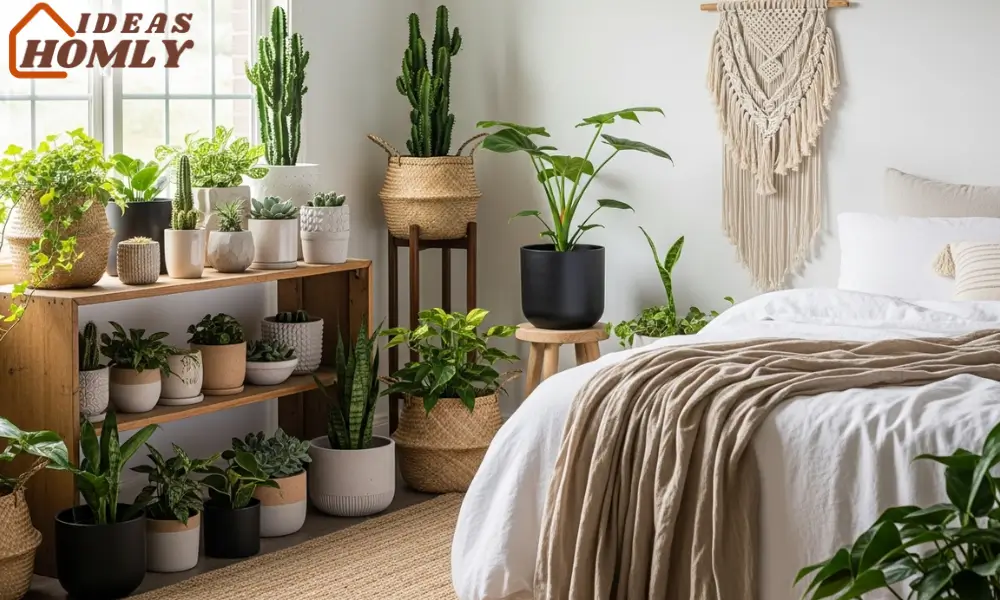
Tips for Maintaining Bedroom Plants
Indoor plants are cute, but they do need a little love. Thankfully, I’ve made all the mistakes (yes, even the “accidentally watered it with coffee” kind), so here’s what I’ve learned.
1. Pick Plants That Match Your Lifestyle
Don’t get a tropical diva if you forget to water for weeks. Snake plants, ZZ plants, and pothos are practically indestructible. If you want a drama queen like a fiddle leaf fig, be prepared for attitude.
2. Rotate Plants Every Week
Sunlight isn’t always even. Rotating helps them grow evenly and avoid looking lopsided, like they’ve been reaching for the fridge light instead of the window.
3. Don’t Overwater
This is the #1 plant killer. I touch the soil before watering, if it’s still damp, hands off. Overwatering causes root rot faster than you can say, “But I thought it looked thirsty.”
4. Keep Humidity in Check
Bedrooms can get dry, especially with AC. I use a spray bottle mist for tropical plants or place a small tray with water and pebbles nearby. No, you don’t need a rainforest but they appreciate a little spa treatment now and then.
5. Clean the Leaves
Dust doesn’t just look bad, it blocks sunlight. Wipe those leaves gently with a damp cloth every couple of weeks. Your plants will literally breathe easier.
Conclusion
Bringing indoor plants and natural textures into your bedroom isn’t just about design, it’s about feeling connected to something calming and real.
Whether you’re suspending ferns from macrame shelves or pairing big leafy friends with reclaimed wood, each touch adds warmth and character. It’s about creating a space that reflects you relaxed, grounded, and maybe just a little bit plant-obsessed (guilty).
The textures from soft moss to rugged driftwood aren’t just for looks. They tell a story. And if that story involves a few too many succulents or a rogue spider plant? Even better.
Start with one idea. See how it feels. And before you know it, your bedroom will be less “sleep space” and more “stylish sanctuary.”
FAQs
Absolutely. Keep your plants healthy, avoid overwatering, and don’t let dead leaves pile up. Most pests show up because of poor care or standing water. Use indoor potting soil and clean your planters regularly, you’ll be fine.
Snake plants, pothos, and peace lilies thrive in low light. They don’t need much sun and can even handle corners. Just don’t tuck them into a completely dark spot, plants still need some indirect light to stay happy.
Try linen curtains, bamboo blinds, or rattan planters. These materials soften modern lines and add warmth without clashing. I like mixing sleek with raw textures, it creates balance and keeps the room from feeling too cold.
Yes, but only during growing seasons (spring and summer). I usually use a mild liquid fertilizer every few weeks. In winter, they rest so skip the feeding unless you want confused, overexcited plants in December.
Stick to a consistent color palette and planter style. You can mix plant species, but unify them with pots in similar materials or tones. Group them by height and type to create harmony without making it look like a garden center exploded.

